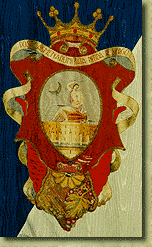| |
 The words of the
great writer, recently dead, who dedicated some of his
most beautiful lines to its Comiso, give
us an idea of the fundamental peculiarity of this town
gently settled on the Ippari plain. The rhythm of Comiso
is marked by its variety, the continuous ups and downs of
its narrow streets between the plain and the mountain,
the flights of steps, the white stone which is present
anywhere, the bell towers of the churches soaring into
the sky, the fountains, the squares, the mosaics and the
palaces. Comiso is rich of bell towers, domes, roofs and
white, rose and ochre fašades. The words of the
great writer, recently dead, who dedicated some of his
most beautiful lines to its Comiso, give
us an idea of the fundamental peculiarity of this town
gently settled on the Ippari plain. The rhythm of Comiso
is marked by its variety, the continuous ups and downs of
its narrow streets between the plain and the mountain,
the flights of steps, the white stone which is present
anywhere, the bell towers of the churches soaring into
the sky, the fountains, the squares, the mosaics and the
palaces. Comiso is rich of bell towers, domes, roofs and
white, rose and ochre fašades. The story of the town of Comiso Kasmenai
is the mysterious name from which the official story of
this very ancient town starts. Before Kasmenai in the
mountain range at whose feet stands Comiso, there was a
natural environment where Siculi and Sicani,
ancient Sicilian populations, extracted and worked the
flint-stone. Pindaro described this landscape in the
fifth of the Olympic Odes. The natives lived in the
limestone caves and huts. They founded big necropolis
such as the ones of Monte Rito, Passo Marinaro and Monte
Casasia whose ruins were still visible some centuries
ago. From the settlements of these hills, the inhabitants
dominated the valley rich of herds and woods. As Tucidide
tells us in his writings dedicated to the origins of the Siceliote
towns, Casmene was founded between Kamarina and Akrai
by the Greek Syracusans in 642 as a fortified town in a
hill called "Cozzo di Apollo" and it was
destroyed by the Romans in 212. Its existence was
revealed by the philologist Margherita Margani and the
archaeological findings were brought to light in a large
area called Castiglione.
The centre of the present town
is the Fountain of Diana which is also the nucleus around
which the town was rebuilt by the same survivors who, up
on the valley called it Yhomisus Casmenarum. In this
site, a very beautiful roman mosaic representing Neptun,
the Nereids and the dolphins decorated the "Dianae
Fons" which fed the roman thermal baths dating back
to the II century A.D.. Near the fountain stood the
temple of Diana; in this place was later built the small
church of St Nicolas and afterwards the wonderful
basilica of Annunziata.
The temple of Apollo dominated
the acropolis from the highest peak of the town, while in
the area of the ancient "docking place", where
even Phoenicians arrived with their ships, there are
still the ruins of the Castrum, the Roman military
quarters. The legend of Apollo tells that the God of Sun
lived on the "Cozzo"as a prince and his sister
Diana used to wash herself in the fountain and to bring
up to the top a pitcher of limpid and fresh water.
|